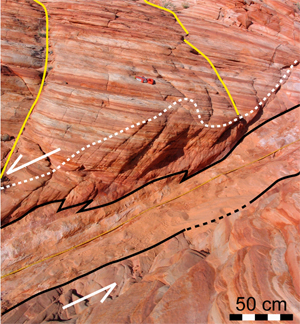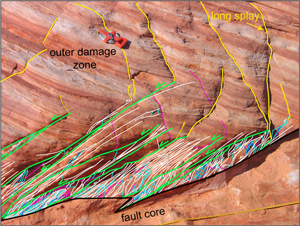| |||||||
|
|
|||||||
|
|
|||||||
| Fault Damage Zones | |||||||
|
Damage zone refers to the fractured body of rock surrounding a fault core. Depending on whether they are later filled, the fractures in a damage zone can be conduit or barrier for fluid flow. So, the nature of the fractures, their density, and the width of the damage zone are important in estimating the permeability of a fault zone. The fractures in the damage zones are splays produced during the growth of faults. Thus the width of a damage zone can be correlated to other properties of the fault, such as length and maximum slip. Please refer to the section 'Scaling between Fault Length and Fault Damage Zone Width' for more discussion. de Joussineau and Aydin (2006, 2007) documented the damage zones of strike-slip faults in Aztec Sandstone exposed in Valley of Fire State Park, Nevada. They classified the damage zones into two distinct components, the inner zone and the outer zone (Figure 1 and Figure 2). The inner damage zone directly flanks the fault core. It is characterized by high fracture frequency and a thickness that shows little variation along the fault and increases with increasing amounts of slip. The outer zone is adjacent to the inner zone, characterized by low fracture frequency, with longer fractures yet more variable length. For more discussion about the geometry of the damage zone presented by de Joussineau and Aydin, please refer to sections in the Related Links.
| |||||||
| Reference: |
|||||||
| Auzias, V., Rives, T., Rawnsley, K.D., Petit, J.P., 1997 de Joussineau, G., Aydin, A., 2006 de Joussineau, G., Aydin, A., 2007 Rawnsley, K.D., Auzias, V., Petit, J.P., Rives, T., 1997 |
|||||||
|
Readme | About Us | Acknowledgement | How to Cite | Terms of Use | Ⓒ Rock Fracture Knowledgebase |
|||||||

